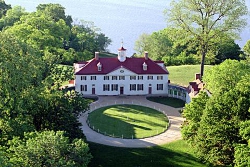The Twenty-Second Inforum World Conference in Alexandria, Virginia, USA
The twenty-second Inforum World Conference was held in Alexandria, Virginia from August 30th to September 6th, 2014. The conference hosts were Inforum's partners from the University of Maryland. Alexandria sits less than 7 miles south of Washington, D.C. and is located on the banks of the Potomac River. Founded 265 years ago, Alexandria is rich in American history.
Monday, 9/1/2014
David Mullins and Nomsa Phindile Nkosi (South Africa) Activating the SAFRIM model in calculating the Macro-Economic impact of greenhouse gas mitigation on the South African economy
Nikita Suslov (Russia) Renewable Energy Sources in Energy Abundant Economy: Russia is in the Focus (Slides)
Ron Horst and Troy Wittek (USA) Inforum IT in 2014: Demonstrating the Collection, Compilation, and Publication of Information (Slides)
Christo Joubert, David Mullins, and Nomsa Phindile Nkosi (South Africa) Macro-Economic Impact Analysis of the South African Broiler industry applying the South African INFORUM Model (SAFRIM) (Slides)
Toshiaki Hasegawa (Japan) - Verification of Economic Sacrifice Caused by the Great East Japan Earthquake
Tuesday, 9/2/2014
Georgy Serbryakov (Russia) - RuNA: The Russian National Accounts Model
Gazi Ozhan (Turkey) - The New Structure of TURINA (Turkish Model)
Alexey Yantovskiy (Russia) - Forecasting of the Russian Economy: Energy Sector Model
Nafiza Bakhtizina (Russia) - Macroeconomy and Primary Energy Consumption
Vasilli Akimov (Russia) - Electricity output modeling and forecasting
Tatiana Fokina (Russia) - Oil consumption modeling and forecasting
Nina Ryabtseva (Russia) - Coal consumption modeling and forecasting
Ron Horst and Jeff Werling (USA) - Infrastructure and the U.S. Economy
Velga Ozolina (Latvia) - Forecasting Tax Revenues in Latvia: Analysis and Models
Natalia Bozo (Russia) - The impact of macroeconomic factors on the structure of the Russian economy
Wednesday, 9/3/2014
Ksenia Savchishina (Russia) - Long-term forecast of Russian Economy (using Russian Interindustry Model RIM)
Vadim Gilmundinov (Russia) Modeling the Impacts of Monetary and Fiscal Policy in the Russian Economy (Slides)
Mariusz Plich (Poland) - The Impact of Possible Shale Gas Extraction on the Polish Economy
Tatyana Tagaeva (Russia) - Ways to Improve Environmental Policy in Russia (Slides)
Thursday, 9/4/2014
Shantong Li (China) - Patterns of Interprovincial Trade in the PRC: 1987 - 2007
Alexandr Shirov (Russia) - The Possible Timing of an FTA Creation Between the European Union and the Eurasian Economic Union
Somprawin Manprasert (Thailand) Demographic Change and Consumption Pattern in Thailand
Britta Stover (Germany) Demographic Change and Consumption: How Aging Affects the Level and Structure of Private Consumption
Vadim Potapenko (Russia) Demographic Projections in RIM (Russian Interindustry Model)
Theo Sparreboom (Switzerland) Employment projection models, job quality and education
Douglas Meade (USA) Uhuru: An Economic Model for Understanding Human Capital Development Needs in Tanzania
Maurizio Grassini (Italy) From Factors Content to Trade in Value-Added
Douglas Nyhus (USA) The Supply Side of Health Care in the U.S. Economy
Friday, 9/5/2014
Meral Ozhan (Turkey) - Equations for the Turina Model
Yu-Wen Su (Taiwan) INFORTW: An interindustry forecasting model of the Taiwanese economy (Slides)
Rossella Bardazzi and Leonardo Ghezzi (Italy) On Linking Country Models Through Bilateral International Trade Flows: Data and Modeling Equations
Alexandria, a small, charming, very walkable city with much to share, is one of of the United States' most historic cities, dating back to our colonial era with a fairly significant number of buildings from the pre- and post-revolutionary times. It is situated on the Potomac River and was once one of the ten busiest ports in America. Located less than seven miles from Washington, D.C. and founded in 1749 by Scottish merchants eager to put its natural harbor to use shipping goods to England, the city plan, which was devised by the Virginia House of Burgesses, was plotted by a young surveyor named George Washington. Alexandria hosted the first conference to frame the U.S. Constitution, was the site of the first casualty of the Civil War, and endured the longest Union occupation of the war.
From its harbor, colonial sea captains plied the triangle trade routes carrying local crops to England, and returned with manufactured goods and the produce of the English Caribbean colonies. The pineapple, a common motif in Alexandria, is a symbol of welcome and hospitality. It recalls the open house given for neighbors that marked a captain's return from a sea voyage, and this exotic fruit served as the table's centerpiece.
The market square, located on King Street just east of Washington Street, is still in use as a public market every Saturday morning.
Photos will be posted here when available.



